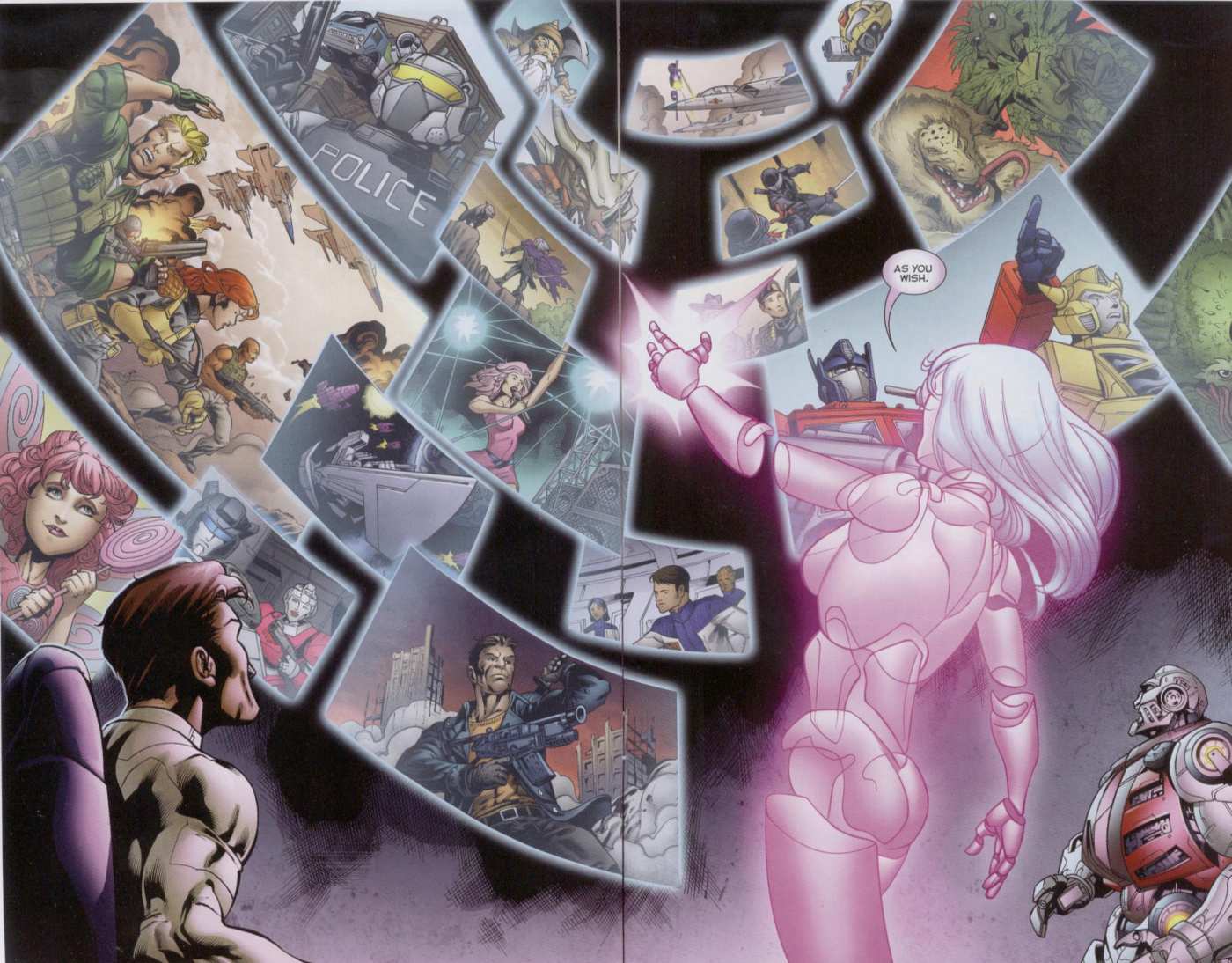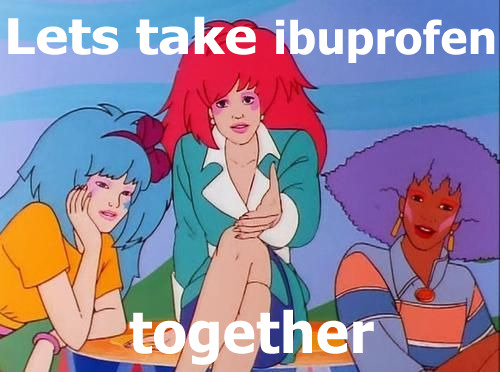It's Over, But It Never Ends: Unit:E and the dregs of the MCU Gold Rush

At New York Comic Con 2011, Hasbro’s ‘HasLab’ division released a one-shot crossover comic called ‘Unit:E’
Unit:E is the kind of crossover comic that has become passe in the era of Fortnite subsuming every media franchise in history, Batman teaming up with the FaZe Clan, and Godzilla stomping over the Call of Duty Warzone island while Snoop Dogg smokes a blunt. Synergy, a very eighties take on a mega-computer from Jem & The Holograms redesigned as an alien AI, spends the comic showing a guy a bunch of holograms of various toy lines for the purpose of being like “Wow, I can’t believe Drizzt Do’urden and Jerrica Benton might team up with Action Man and Rodimus Prime” and then the characters promptly decide to venture out into the multiverse to collect the heroes.
They were seemingly ahead of the curve in what would soon become the defining fail-trend of the 2010s: attempting to merge your brands into one overarching ‘shared universe’ in the hopes of cashing in on the success of the nascent MCU. It made sense at the time, in that cynical corporate executive way: increasing production costs on physical goods meant that toys and other physical media was quickly becoming inaccessible to their intended audience of children, and so the ‘core business’ of any comics or toy company became a secondary concern to ensuring the profitability of ‘the brand’ through other mediums, usually film or television. This was the era of content, where companies were valued by the IP they held and could routinely exploit. In an environment where zero percent interest rates could be leveraged to print free money to finance dozens of media projects in the hopes that one stuck, the battle for ‘market share’ led companies to buying out media libraries for the rights to develop them into new projects that would drive eyeballs towards streaming platforms.
At the time, Hasbro were gearing up to launch the Hub Network, a joint cable venture between themselves and Discovery, which was built on the content-driven impulse of this ‘market share’ gold rush but proved to be a distinctly ‘old media’ affair in an era where Netflix was beginning to develop original programming and cord cutting was becoming a viable (and cheaper) option for most families than traditional cable.
Due to this ‘legacy media’ approach, they were approaching the era of MCU copycats from a different angle, and merging their toy lines for reasons that were more akin to the continuity-averse reboots that were prevalent over the previous decade. Over the years, the wildly divergent takes on a franchise like Transformers across decades of comics, cartoons, embarrassing Michael Bay movies, and other media had led to a toy line predicated on ‘good robots aligned with humans who want to beat up bad robots who hate humans’ devolving into a tangled mess of conflicting ‘continuity families’ of overlapping toy brands. They wanted to do an 2001-style ‘Ultimate Marvel’ rebranding, consolidate everything related to Transformers down into one overarching setting, and never have to deal with issues like ‘is Rumble supposed to be Blue?’ or ‘Wait, is Starscream still transgender in this timeline?’ ever again.
So guys like Aaron Archer, Rik Alvarez, and Fabian Nicieza were brought in to try and make a big setting bible that would solve everyone’s complaints about Transformers canon, rank characters in order of importance for future adaptations, and ensure they would never be left in a massive clusterfuck of trying to untangle all of the knots between various iterations of their toyline ever again. A new cartoon, Transformers Prime, was going to launch the unified vision of the franchise, IDW’s independently produced line of Transformers comics were supposed to be rebooted in the style of the then-upcoming New 52 to integrate all the new lore, and two action games from Activision were going to definitively show the fall of Cybertron and establish the setting backstory.
Cool? Cool.
It failed immediately and completely, for reasons that are obvious to anyone who looks at Hasbro’s model of licensing out media and toy production to external partners. Consolidation requires everyone to be on the same page, which becomes exponentially more difficult the more parties are involved, and issues regarding the production of Prime filters out to all the tie-in projects that were supposed to revolve around it and the whole thing collapses under its own weight basically instantaneously.
People get fired, or walk in acrimonious fashion, and the big setting guide they spent a quarter of a million dollars making gets put to one side.
IDW never gets around to doing that reboot, because comic books were undergoing a renaissance in the 2010s off the back of Image Comics and other smaller publishers that meant they would be tethering their relatively successful comics to a media initiative that was falling the fuck apart at the seams, and James Roberts and Nick Roche had basically already done their own successful soft-reboot smoothing out the edges of the IDW canon anyway so it would be like taking a bulldozer to a sandcastle.
So Unit:E dropped into the middle of this absolute clusterfuck of collapsing promises, promising to extend the Transformers Prime approach to a unified continuity out to the other toylines. A planned tie-in to future projects in Transformers Prime (Unit:E was supposed to be the name of an in-universe faction) gets dropped amidst the chaos, and the HasLab division responsible for pitching the Unit:E idea gets permanently shuttered a few months later, only returning in later years as a brand label for expensive toys aimed at the adult collector market.
It becomes a largely forgotten piece of franchise ephemera, only ever really brought up when people look at later attempts to do the same concept, like the IDW’s 2016 attempt to merge their failing GI Joe line with their thriving Transformers line through the Revolution event, or the ongoing GI Joe/Transformers crossover Energon Universe from Skybound.
It’s also not the reason Unit:E is interesting to me.
Because Unit:E served another purpose for Hasbro: it was intended to be a coming out party for toy franchises whose media rights they had recently re-acquired from the now-defunct Sunbow Entertainment, with whom they had co-produced many of their most successful cartoons in the eighties and some of their most embarrassing in the nineties. The nature of these co-productions (Marvel was also involved, before their own financial woes led to New World Pictures buying them outright in 1989) meant that some shows were toys first and cartoons second, so Hasbro could revive the toy lines and shop new adaptations around without involving Sunbow or Marvel, and some shows were cartoons first and toys second, which meant that reviving a show like Jem & The Holograms or Inhumanoids bordered on impossible even as franchises like Masters of the Universe or the Teenage Mutant Ninja Turtles had successful relaunches in the early 2000s.
This rabbit hole started a few months back, when I wondered why there was never a Jem & The Holograms reboot in 2003, alongside the other 80s toyline revivals, a 'SaveJem' campaign orchestrated by fansite owners around this time, and the wave of 'alt girl fashion' dolls like Bratz that a Jem revival would've been tailor made to fit into. The closest information I could come across was an interview with series creator and certified madwoman (DEEPLY affectionate) Christy Marx in 2004, where she stated simply that the show never came back because the rights situation was complicated.
So, I started untangling this knot.
This is also where I need to come clean and admit that I’m writing this post primarly as necessary context for a longer series of articles I’ll be posting on this website over the next few weeks. Because Unit:E, and Hasbro’s position in the 2010s of reacquiring the media rights to its 1980s toy lines and subsequent failed attempt to consolidate them into one unified setting, is the end point of the story. It's also the start of a much longer rabbit hole I’ve fallen down in recent weeks; one that involves post-Reunification German Politics, the collapse of the Japanese bubble economy, a French cosmetic brand being swindled by a businessman into buying out a film studio that no longer existed, shell companies being set up to bypass MPAA regulations, British children’s television programme Dick & Dom in da Bungalow, failed attempts at marketing Canadian animation imports on US television, and a company betting it all on The Cramp Twins to reverse their declining fortunes.
I also get to talk about my favourite comic book of all time, Dan Abnett & Andy Lanning's 2008 Guardians of the Galaxy series, and the legal squabbles between Marvel and Hasbro that almost sank the film adaptation.

Friends, it’s time to talk about the decline and fall of Sunbow Entertainment.